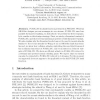Free Online Productivity Tools
i2Speak
i2Symbol
i2OCR
iTex2Img
iWeb2Print
iWeb2Shot
i2Type
iPdf2Split
iPdf2Merge
i2Bopomofo
i2Arabic
i2Style
i2Image
i2PDF
iLatex2Rtf
Sci2ools
133
click to vote
CTRSA
2007
Springer
2007
Springer
Cryptanalysis of Reduced Variants of the FORK-256 Hash Function
FORK-256 is a hash function presented at FSE 2006. Whereas SHA-like designs process messages in one stream, FORK-256 uses four parallel streams for hashing. In this article, we present the first cryptanalytic results on this design strategy. First, we study a linearized variant of FORK-256, and show several unusual properties of this linearized variant. We also explain why the linearized model can not be used to mount attacks similar to the recent attacks by Wang et al. on SHA-like hash functions. Second, we show how collision attacks, exploiting the non-bijectiveness of the nonlinear functions of FORK-256, can be mounted on reduced variants of FORK-256. We show an efficient attack on FORK-256 reduced to 2 streams and present actual colliding pairs. We expect that our attack can also be extended to FORK-256 reduced to 3 streams. For the moment our approach does not appear to be applicable to the full FORK-256 hash function.
Related Content
| Added | 07 Jun 2010 |
| Updated | 07 Jun 2010 |
| Type | Conference |
| Year | 2007 |
| Where | CTRSA |
| Authors | Florian Mendel, Joseph Lano, Bart Preneel |
Comments (0)

